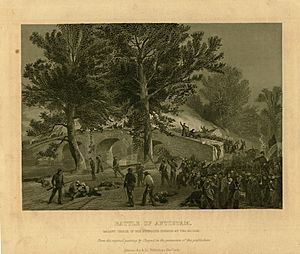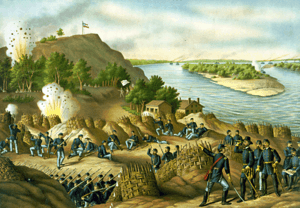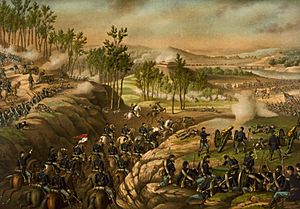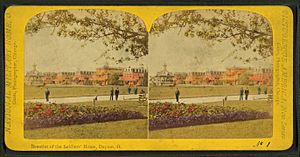Uriah Brown facts for kids
Quick facts for kids
Uriah H. Brown
|
|
|---|---|
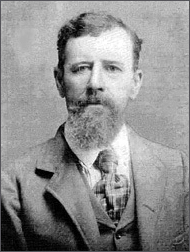 |
|
| Born | July 4, 1841 Covington, Ohio |
| Died | January 24, 1927 (aged 85) Hollidays Cove, West Virginia |
| Buried |
Paris Cemetery, Washington County, Pennsylvania
|
| Allegiance | |
| Service/ |
Union Army |
| Years of service | 1861–1865 |
| Rank | Private |
| Unit | |
| Battles/wars | American Civil War |
| Awards | |
Uriah H. Brown (1841–1927) was a brave soldier from the United States who fought for the Union Army during the American Civil War. He was part of Company G, 30th Ohio Infantry. Uriah Brown received the Medal of Honor, which is the highest award for bravery a soldier can get. He earned it for his actions during the Battle of Vicksburg in Mississippi on May 22, 1863. He received this special award on August 15, 1894.
Contents
Early Life
Uriah H. Brown was born in Covington, Ohio, on July 4, 1841. His father, William Brown, was also from Ohio.
Uriah was a member of a Christian church group called the Disciples of Christ. Later in his life, he was part of the First Christian Church in Weirton, West Virginia.
Serving in the Civil War
Uriah Brown joined the Union Army in August 1861 in Steubenville, Ohio. He became a private in Company G of the 30th Ohio Infantry.
After getting their weapons and gear, Private Brown and his unit were sent to the battlefield. They traveled by train to Virginia. On September 2, they arrived in Clarksburg and prepared to join Union Army troops led by General William Rosecrans. They marched through the night and camped near Weston.
The 30th Ohio Infantry moved around a lot. While some parts of his unit fought at Carnifex Ferry, Uriah Brown's company was not involved. Later, in November, his company did fight Confederate troops near Crites Mountain. By late November 1861, the Union Army had pushed Confederate forces out of what is now West Virginia. Brown's unit then settled into winter camps. They spent December tracking down enemies and helping Union-loyal families. They even had a Christmas celebration with food and fun.
1862 to Early 1863
In early 1862, the 30th Ohio was stationed in Fayetteville. They marched to several towns, including Princeton. Sometimes, food was very scarce, and soldiers had to live on very little. They often had to leave their warm clothes and tents behind to travel faster, which they later regretted when the weather turned cold and rainy.
In August, the regiment marched 95 miles to Brownstown. They traveled by steamboat and then by train, passing through Washington, D.C., and Alexandria, Virginia. They helped defend Washington, D.C., from Confederate forces. In September, they joined the Union Army's Kanawha Division, led by General Marcus Reno. This division was part of a larger force under General Ambrose Burnside.
In September, Brown's regiment advanced toward the Antietam Creek. They lost many men in battles. On September 17, the 30th Ohio was at the front of the Union attack during the Battle of Antietam. It was a very confusing and bloody battle. The regiment's flags were hit many times by enemy bullets. One historian wrote that "the balls flew like hail." After the battle, on September 19, they buried their dead. Weeks later, President Abraham Lincoln and General George B. McClellan reviewed the troops. The regiment continued to pursue the enemy and then moved into winter camps in November 1862.
Throughout early December, the regiment kept moving, searching for Confederate troops. They captured 19 enemies and 75 horses. In January 1863, Private Brown and his unit sailed down the Ohio River toward Vicksburg, Mississippi. They joined Major-General William Tecumseh Sherman's 15th U.S. Army.
The 30th Ohio helped strengthen Union defenses near Vicksburg. They also worked to improve a canal to help move troops and supplies. In March, they found important Confederate plans at an abandoned mansion. Later that month, they sailed back to Young's Point, Louisiana. On April 21, they heard an important announcement from General Lorenzo Thomas about President Lincoln's plan to arm African American soldiers.
On April 29, Brown's regiment joined other Union forces on gunboats. They sailed to the Yazoo River. General Sherman announced that their mission was to distract the enemy at Hain's Bluff while General Ulysses S. Grant landed troops at Grand Gulf. They exchanged artillery fire with the enemy, eventually forcing the Confederates to leave their strong positions. The 30th Ohio then moved toward Richmond and New Carthage.
On May 9, Private Brown and his company guarded Union supplies in Richmond. They rejoined their regiment the next day. They saw many local people suffering and asking Union troops for food. On May 13, they continued their journey, marching through swamps and staying in former slave cabins. They reached Grand Gulf and began a march toward Jackson. They learned that Jackson had been captured by Union forces. On May 18, they camped very close to Vicksburg. On May 19, they joined other Union troops in attacking Fort Beauregard during the Siege of Vicksburg.
The attack failed, and the Union forces regrouped. On the afternoon of May 22, the 30th Ohio positioned themselves close to the enemy and began firing. This was the start of the Battle of Vicksburg.
Battle of Vicksburg (May 22, 1863)
During the American Civil War, Uriah Brown was part of a special group called the "volunteer storming party" or "forlorn hope" on May 22, 1863, at Vicksburg. They were ordered by General Ulysses S. Grant to attack Vicksburg a second time. Brown and many of his comrades were wounded while trying to place ladders against a fort. Even under heavy enemy fire, Uriah Brown bravely rescued five men. Many other soldiers, including his company captain, were killed instantly during this dangerous attack.
After this battle, the Siege of Vicksburg continued. On July 4, 1863, the city finally surrendered when General John C. Pemberton and his Confederate troops gave up to the Union Army. After recovering from his wound, Brown returned to his regiment. As the war continued, he and his unit marched as part of the 15th Army Corps. They participated in the Siege of Jackson in July, then moved to Memphis and Chattanooga. They were involved in battles around Chattanooga in November and helped relieve Knoxville.
1864 to 1865
In 1864, the 30th Ohio moved to Tennessee. Many soldiers, including Brown, chose to re-enlist for more time in the army. They were given leave to go home for a short time. From May to September, the 30th Ohio was part of the Atlanta Campaign. They fought in the Battle of Resaca in May. They also took part in operations around Dallas, New Hope Church, and Kennesaw Mountain. They fought in the Battle of Atlanta on July 22 and were part of the Siege of Atlanta until August 25. They also fought at Jonesboro and Lovejoy Station.
When Uriah Brown's first three-year service ended in September 1864, he chose to re-enlist with the 30th Ohio Infantry.
His unit then fought against General John Bell Hood's Confederate forces in North Georgia and Alabama. They were part of Sherman's March to the Sea from November to December, which ended with the Siege of Savannah. As the war entered its final year, they joined the Campaign of the Carolinas in 1865. They fought in the Battle of Bentonville, North Carolina, in March. After that, they were stationed in Goldsboro. They marched to Raleigh and were there when Johnston's army surrendered. They then marched to Richmond and Washington, D.C., where they took part in the Grand Review of the Armies on May 24, 1865. The regiment was officially discharged from service on August 13, 1865.
Private Brown's service lasted a little longer. He was honorably discharged on September 14, 1865.
Life After the War
After leaving the military, Uriah Brown became a civilian again. In the mid-1860s, he worked as a carpenter in West Virginia. He married America/Americus (Loland) Brown. They had a son, Lee, around 1865, and a daughter, Mary Jane, born in Hancock County, West Virginia, in 1868.
In 1870, Brown was a farmer in Virginia with his wife and two children. Another daughter, Alice Ellen, was born in 1882, and Rebecca was born in 1886.
Around 1884, Brown married again to Sarah Elizabeth Greer.
By 1890, he lived in Florence, Pennsylvania. A special government census that year noted his service in the 30th Ohio and that he had been "twice wounded." On August 15, 1894, his bravery during the Civil War was officially recognized when he received the U.S. Medal of Honor.
Later Years and Passing
Around 1900, Uriah Brown was still farming and living with his second wife, Sarah, and his daughter, Alice (Ella), from his first marriage. The census confirmed he had been married twice.
In 1906, Brown began receiving a U.S. Civil War Pension of $12 per month. This amount increased over the years, reaching $100 per month by 1927. The increase was due to his increasing disability from his Civil War wounds. This pension also included a special payment for Medal of Honor recipients.
On February 11, 1918, he was admitted to the National Home for Disabled Volunteer Soldiers in Dayton, Ohio. He was diagnosed with heart and blood vessel problems, as well as an "old injury to head." He was described as 5'7" tall with dark hair and blue eyes. He left the home at his own request in March of that year.
In the fall of 1924, his daughter, Ella, passed away in West Virginia. She was buried in the Paris Cemetery in Washington County, Pennsylvania.
Uriah Brown suffered from kidney disease and passed away from complications in Hollidays Cove on January 24, 1927. He was buried at the Paris Cemetery in Washington County, Pennsylvania.
See also


